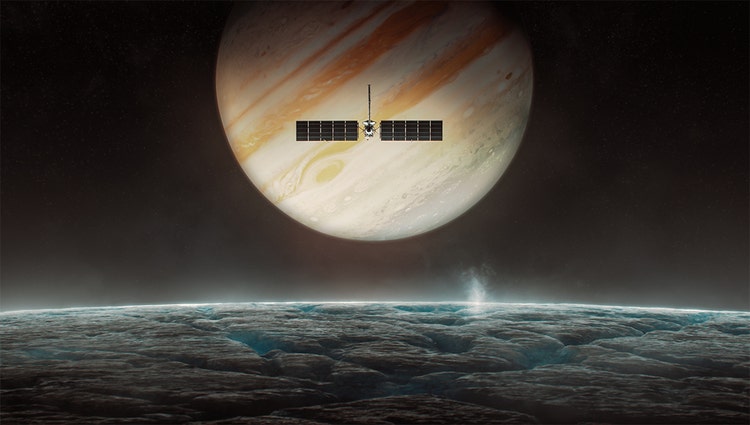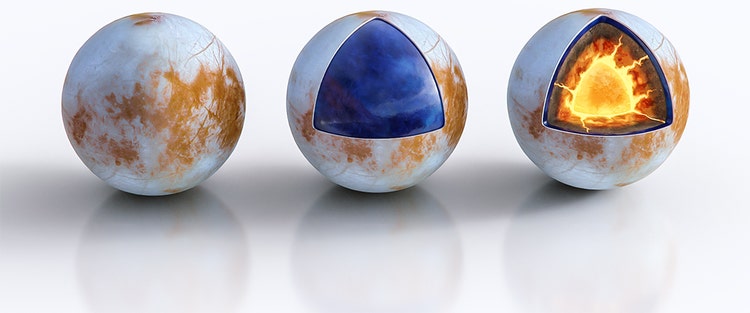Searching for life on Jupiter’s icy moon.
NASA brings the public onboard the Europa Clipper mission.

NASA brings the public onboard the Europa Clipper mission.
Created 146 high-fidelity assets, including ones that leverage NASA imagery to accurately replicate the surface of Europa, one of Jupiter's moons


Use creative storytelling to engage the public and drive excitement around space science
Create an augmented reality experience that introduces users to the Europa Clipper mission
Deliver visuals with both a high degree of realism and scientific accuracy
Improve accessibility with an interactive experience that the public can view from their mobile devices anywhere at anytime

Developed an augmented reality experience that includes more than 30 interactive elements
Engaged audiences of all ages with the Europa Clipper in multiple spaces, including at in-person events, in classrooms, and at home
Created 146 new assets, including highly realistic 3D assets that leverage actual NASA imagery such as the surface of Europa
Shared AR experience through a single link with no app installation required on mobile devices
From sending rovers to Mars to designing instruments for space telescopes, NASA’s Jet Propulsion Laboratory (JPL), managed by the California Institute of Technology, has been on the forefront of space science since 1936.
As all missions are taxpayer funded, JPL aims to disseminate information about its missions and the science behind them as widely as possible — across the United States and to partners worldwide. When engaging with the public, JPL’s Public Engagement team focuses on what makes each mission unique, from what scientific lessons may be learned to what new innovations are required to accomplish those goals.

Adobe Substance 3D Stager scene depicting Clipper spacecraft on a flyby over Europa's surface with Jupiter rising in the background.
One of NASA’s most exciting upcoming missions is Europa Clipper, when NASA will send its largest ever planetary mission spacecraft to explore one of Jupiter’s 80 plus moons, Europa. Slightly smaller than Earth’s moon but one of Jupiter’s largest, what makes Europa so special is its icy shell. And where there is ice, there is potential for liquid water — and where there is liquid water, there is potential for life. Europa has all of the ingredients for life: water, chemistry, and energy. In October 2024, NASA plans to launch the Europa Clipper spacecraft to conduct detailed investigations of Europa and possibly answer the intriguing question of whether there is life, or the potential for life, under the ice.
JPL planned a multi-layered campaign to engage the public on this mission: an engaging website, in-person events such as a touring road show and pop-up events at aquariums, and the Message in a Bottle campaign that invites individuals to send their name into space alongside a poem from U.S. poet laureate Ada Limón. But the organization was also interested in creating an immersive 3D experience with augmented reality (AR) to encourage interaction and help the public — from die-hard space fans to people who have never heard of Jupiter’s moons — understand the scale of the Europa Clipper and its mission.
JPL oversaw the development of ClipperAR: an immersive augmented reality experience that allows the public to explore Europa and the Europa Clipper spacecraft. The Substance 3D team at Adobe created the groundbreaking experience using the Adobe Substance 3D Collection and Adobe Creative Cloud apps, turning actual NASA assets and data into photorealistic 3D models still light enough to run on a mobile device for a seamless AR experience.
“For NASA, scientific accuracy is a priority. The ability to plug in existing NASA satellite images to Substance Sampler and produce 3D material which precisely matches Europa's surface in real life, was huge.”
Vladimir Petkovic
Creative Director, Substance 3D team, Adobe
The Adobe Substance 3D team started with source materials from NASA — including 3D models of the Clipper and its instruments — and upleveled the models with Substance tools to create even more realistic, AR-friendly lightweight assets. 3D artists first cleaned up geometry and then retextured assets using Substance 3D Painter. Some of the textures came from the Substance 3D Assets library, while others were custom materials created using the node-based workflows in Substance 3D Designer. By layering materials together with Substance Painter, artists captured the slight bumps and imperfections that create complex light patterns to make the Clipper feel real.
The updated 3D models can be reused across multiple contexts, from the JPL website to marketing imagery. The Adobe 3D team used the updated Clipper model to create a hero image that JPL’s Public Engagement team use when marketing the ClipperAR experience. The image shows the Clipper flying in front of Jupiter, with the icy surface of Europa beneath it. By feeding Sampler with satellite images of Europa's surface, the Adobe team used Sampler to extract elevation data and produce a material which illustrates how this terrain looks in real life.

NASA satellite data was used to extract the elevation map using Adobe Substance Sampler and then a 3D model of the surface was made in Adobe Substance Painter.
“For NASA, scientific accuracy is a priority,” says Vladimir Petkovic, Creative Director, Substance 3D team at Adobe. “The ability to plug in existing NASA satellite images to Substance Sampler and produce 3D material which precisely matches Europa's surface in real life, was huge. While we could have done this manually, working with NASA's source data allowed us to improve accuracy and speed up our creative workflow. I used Substance 3D Stager to set up a 3D scene where I could adjust the lighting, camera angle, and composition very quickly to achieve just the right image to visualize the magnitude of the Europa Clipper mission.”
When people open ClipperAR, they are greeted by the solar system spinning amongst a field of stars with the title, “Journey to an Ocean World.” The planets then fade away to highlight Jupiter, followed by Europa. Users are invited to click on three buttons — Water, Chemistry, and Energy — to hear narration and watch infographics that explain how these elements can combine to form life. Finally, they are introduced to the Europa Clipper itself. People can walk around the Clipper, view it from different angles, and click on points of interest to get a closer look at individual instruments, such as the magnetometer used to measure magnetic fields or the imaging system that will capture both color and stereoscopic images.
The Adobe 3D team started designing the experience by creating storyboards and a compelling script. This was followed by an animatic designed in Adobe Premiere to visualize the important interactivity and narrative flow of the AR experience. Once approved, the team got to work creating nearly 146 assets, including 2D and 3D visuals, text, audio, and animated sequences, using Adobe Creative Cloud apps.

AR 3D assets showcasing Europa in three states: 1) as a whole 2) cross-section revealing a giant ocean under its icy crust, and 3) cross-section revealing its heated iron core and suspected geo-thermal activities.
Artists used Photoshop to clean up and create new images, such as images of the planets and the field of stars. The 2D interfaces and text displays were created in Illustrator, while After Effects turned some of those elements into animated infographics and titles. While Adobe Stock contributed some of the music and sounds, users are drawn into the experience through narration done by JPL MediaLab and edited using Audition. Media Encoder then takes all of these assets and optimizes formats for the mobile AR experience.
The Adobe 3D team brought the experience to life using 30 interactive triggers, 585 actions, and more than 50 animations. The triggers and actions power the interactivity and movement that makes the AR experience so compelling, such as the ability to click on a pop-up button and see the image of Europa fade away to reveal an explanation of energy.

3D Model image of Europa Clipper spacecraft from NASA with surface reworked in Adobe Substance Painter.
JPL plans to use both the full "Journey to the Ocean World" experience and a shorter, Clipper spacecraft-only AR experience at live events leading up to the October 2024 launch date. Built with the textured and scientifically accurate assets of the Europa moon and spacecraft, the interactive ClipperAR experience helps JPL engage, educate, and connect the public to the mission.
